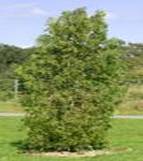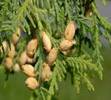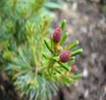| Kingdom | Plantae |
| Division | Pinophyta |
| Class | Pinopsida |
| Order | Pinales |
| Family | Cupressaceae |
| Genus | Thuja |
| Species | T. occidentalis |
| Binomial name | Thuja occidentalis |
Other Common Names:
The other common names for the thuja tree are False White Cedar, Northern White Cedar, Swamp Cedar, Tree of Life, White Cedar, Eastern arborvitae; American arborvitae and Yellow Cedar.
History
The eastern white-cedar is also called northern white-cedar, arborvitae and swamp-cedar. The name arborvitae or "tree of life" dates from the 16th century when the French explorer Jacques Cartier learned from the Indians how to use the tree's foliage to treat scurvy. The rot- and termite-resistant wood is used principally for products in contact with water and soil. The tree provides valuable shelter and browse in winter deeryards, and it is a widely planted ornamental.Thuja, from Theophrastus' name for a resinous, fragrant-wooded tree.

Description



Range
The main range of northern white-cedar extends through the southern part of the eastern half of Canada and the adjacent northern part of the United States. Specifically, it extends westward from Anticosti Island in the Gulf of St. Lawrence to the southern part of James Bay and through central Ontario to southeastern Manitoba; then south through central Minnesota and Wisconsin to a narrow fringe around the southern tip of Lake Michigan; then east through southern Michigan, southern New York, central Vermont and New Hampshire, and Maine.
Habitat
The thuja tree thrives best in a moist, well-drained, loamy soil in full sun, but tolerates soils that are poor, rocky, clay, compacted, dry, and of various pHs extremely well, and is very urban tolerant to heat, drought, humidity, and pollution; however, not tolerant of shady situations. Northern white-cedar generally grows best on limestone-derived soils that are neutral or slightly alkaline and moist but well drained. It is generally seen growing in Swamps and cool rocky banks of streams, forming dense almost impenetrable forests also on rocky soils.
Cultivation
Seeds are best sown when ripe in the autumn in a cold frame. Stored seed germinates best if given a short cold stratification. It can be sown in a cold frame in late winter. When they are large enough to handle, prick the seedlings out into individual pots and grow them on in the greenhouse for their first winter. Plant them out into their permanent positions in late spring or early summer, after the last expected frosts. If growing large quantities of plants, the seed can be sown in an outdoor seed bed in mid spring. Grow the plants on for two years and then plant them out into their permanent positions in late autumn or early spring. Cuttings of half-ripe wood take place in July/August in a shaded frame. Forms roots by the end of September but it should be over wintered in a frame. Cuttings of almost ripe wood, takes place in September in a cold frame followed by formation of roots in the following summer after which it is planted out in autumn or spring.
Flowering Season
The flowering female cones persist and eventually develop a few woody scales oppositely arranged and containing seeds in their axils and are in bloom from April to May.
Pests and Diseases
The Thuja tree with several potential diseases and pests, most of which rarely manifest themselves; however, one annual pest (bagworms, which cause minor to major feeding damage to the new foliage) and one longterm disease (heartwood rot of the interior wood, which leads to a decline in vigor with maturity) are noteworthy. But however they are relatively free of serious insect injury. The principal pests are Arborvitae Leaf miner (Argyresthia thuiella) and black and red Carpenter Ants (Camponotus pennsylvanicus and C. ferrugineus).
Parts Used
Leaves and young twigs are the most commonly used parts of the thuja tree for its commercial and medicinal purposes.
Medicinal Applications


• Thuja is most often used to treat warts and polyps, being prescribed both internally and externally for these conditions.
• Thuja is also used as part of a regime for treating cancer -especially cancer of the uterus.
• A homeopathic remedy is made from the leaves and twigs, gathered when the tree is flowering.
• Thuja may also be used in hot compresses and steam baths to ease rheumatism, arthritis, and achy muscles.
• Thuja is diuretic and is used to treat acute cystitis and bed-wetting in children.
• Externally, the leaves are used as a wash for swollen feet and burns.
• The plant can be used to induce menstruation and so should not be prescribed for pregnant women.
• A tea made from the leaves is used as a stimulating expectorant that is useful for treating bronchitis, colds and other respiratory problems.
Commercial Applications


• It is involved in the making of cabin logs, lumber, poles, shingles, paneling, piling, lagging, pails, potato barrels, tubs, ties and boats (especially canoes).
• The bark is a source of tannin.
• The leaves have been kept in the clothes cupboard as a perfume, incense and insect repellent.
• A yellow-green volatile oil can be distilled from the leaves and used as a vermifuge.
• The leafy branchlets are used as a tea substitute.
• Recently, white-cedar has been used for making kraft pulp and it appears excellent for particleboard.
• The leaves and stems have been used as an incense.
• The inner bark can be dried and ground into a powder, then used with wheat or other cereals in making bread, biscuits etc.
• Cedar leaf oil is distilled from boughs and used in medicines and perfumes; boughs are also used in floral arrangements and is a widely planted ornamental.

Ancient peoples burned thuja's aromatic wood along with sacrifices."Thuja" comes from the Latin form of the Greek word thero (to sacrifice). Other species of thuja were used in Egypt for embalming the dead. The botanist Carolus Clusius called the tree arbor vitae, Latin for "tree of life", when he saw one that had been imported from Canada to France. Native Americans used the plant for canoes, baskets, and perfumes, and sometimes boiled twigs for broth when other foods were unavailable or scarce. Oriental thuja, or Platylactus orientalis, has been popular in China for thousands of years, where thuja was cultivated for religious and ornamental purposes. Frequently mention in the Bible, representing fertility and abundance. King Solomon's temple was said to built entirely from cedar from Lebanon.